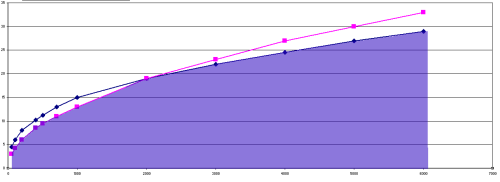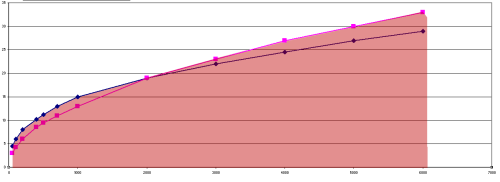Revit provides 4 standard methods for sizing duct:
- Friction
- Velocity
- Equal Friction
- Static Regain
Friction and Velocity Methods
When just the friction or the velocity sizing method is selected, sizing can be based on only the one method, or a logical combination of the friction and/or velocity methods. When both are selected, the size of the duct must comply with both the friction and velocity values. When either is selected, the size of the duct is allowed to break either the friction or velocity rule, but must comply with one rule. The following curves (based on 1000 fpm and 0.08") show the difference between the “Or” and “And” sizing methods:

Friction (![]() ) And Velocity (
) And Velocity (![]() ) Duct Sizing Method
) Duct Sizing Method

Friction (![]() ) Or Velocity (
) Or Velocity (![]() ) Duct Sizing Method
) Duct Sizing Method
Equal Friction and Static Regain Methods
The Equal Friction method creates an initial estimate for duct sizing based on the constant pressure loss per unit of duct length specified (default is 0.10 in-wg/100 ft or 25 Pa/30 m). The Equal Friction and Static Regain methods used in Revit use the ASHRAE Duct Fitting Database, Version 5.00.00, which contains information about losses for various duct fittings. The following table maps fitting and accessory types to the ASHRAE category used to determine loss calculations.
| Fitting/Accessory Type | ASHRAE Category |
|---|---|
| End Cap | Obstruction |
| Intersection | Junction |
| Elbow | Elbow |
| Offset | Elbow |
| Tap (Adjustable) | Junction |
| Tap (Perpendicular) | Junction |
| Tee | Junction |
| Transition | Transition |
| Union | Transition |
| Wye | Junction |
| Lateral Tee | Junction |
| Lateral Cross | Junction |
| Pants | Obstruction |
| Damper | Damper |
| Accessories with BreaksInto behavior | Obstruction |
| Accessories with AttachesTo behavior | Obstruction |